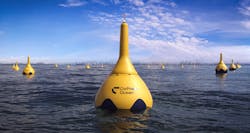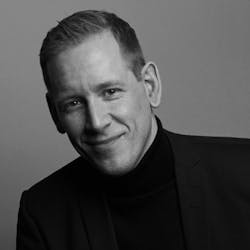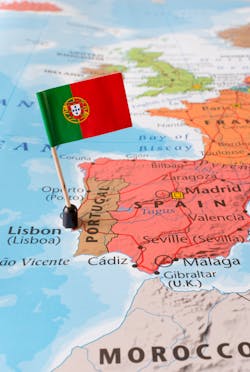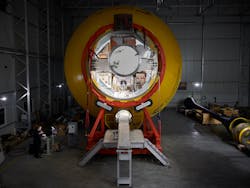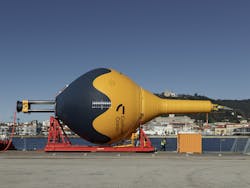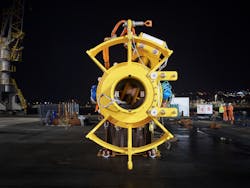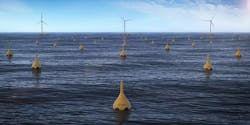Editor's note: A shortened version of this story first appeared in the January-February 2023 issue of Offshore magazine. Click here to view the full issue.
By Ariana Hurtado, Editor and Director of Special Reports
Throughout the industry’s energy transformation, some companies have implemented goals to incorporate more renewable energy initiatives and projects. While wind power is likely the first to come to mind, wave power technology has continued to develop and gain headlines over the past few years.
In short, wave power consists of capturing energy from ocean waves to generate electricity.
CorPower Ocean is a turnkey supplier of wave energy systems. The Sweden-based company’s Wave Energy Converters (WECs) harness clean energy from the oceans, and the wave motion is turned into rotation, which is converted into electricity by generators inside the buoy.
The company details the technology as a heaving buoy on the surface absorbing energy from ocean waves, and the buoy is connected to the seabed using a tensioned mooring system. “Energy stored in waves are converted into electricity through the rise and fall as well as the back-and-forth motion of waves” CorPower explains on its website. “The composite buoy, interacting with this wave motion, drives a power take-off inside the buoy that converts the mechanical energy into electricity.”
Overall, Rebenius has a positive outlook on the future of wave energy and the solutions it can provide.
“The biggest challenge for the world to reach 100% renewables is making sure supply meets demand all hours of the year,” he said. “A mix of different sources are needed that can produce at different times. By successfully harnessing one of the world’s largest untapped clean energy sources—our oceans—we could satisfy 20% of global electricity demand. Wave energy’s more stable and consistent power profile can alleviate intermittency issues, which detract from more established renewables such as wind and solar. Ultimately, wave energy can help stabilize the clean energy mix to provide electricity all hours of the year, unlocking 24/7 carbon-free energy.”
In every aspect of the energy industry, there are skeptics and those that challenge the use and/or benefits of the technology and processes in place. Opposers of wave energy question the advantages, and some believe it’s not a reliable source of energy at all. For instance, one disadvantage can be location, because only power plants and cities near the ocean can benefit directly from wave energy. Non-coastal cities far from the sea have to find alternate sources of power, so wave energy is not the clean energy option in this case. In addition, wave power is dependent on wavelength and wave height to provide sufficient conditions for the system and to be energetic enough, provided by waves built up by different weather systems over several days and that have traveled uninterrupted over oceans before hitting the coastline.
However, Rebenius said the wave sector’s technology improvements are enough to show that wave energy is here to stay.
“The skepticism felt by some is understandable due to the past failures,” he admitted. “However, in my mind, the technical solutions are getting there, and wave energy will become a mainstream energy source over the next decade, competing head-to-head with offshore wind and solar by 2030. I would urge anyone contemplating implementing wave energy, considering different alternatives, to base their decision on data, [specifically] data proving storm survivability and performance in terms of structural efficiency (i.e., power production in relation to installed mass), ensuring a viable business case.”
Pilot installation in Portugal
“Several of our customers have bought into our pilot access program to get in-depth insight into the technology, product design, industrialization efforts as well as installation and operations methods,” he said.
In October 2022, CorPower announced it partnered with Maersk Supply Services to install a 6.2-km subsea export cable off Portugal to energize the HiWave-5 project. The HiWave-5 project is the result of 10 years of product development and 40 years of research on wave hydrodynamics. The company said the project marks a final push toward commercialization as part of a broader mission to make wave energy competitive with wind and solar by 2030. Dry testing is performed in Stockholm, Sweden, with ocean deployment in Agucadoura, Portugal.
The project’s goal is to demonstrate WECs that make wave energy bankable in the market by 2025, allowing end users to secure mainstream infrastructure/renewable energy project finance for pre-commercial arrays. The project team aims to complete demonstration and prototype certification of a single device full-scale (C4) WEC as well as demonstration and type certification of pilot array with three (C5) WECs.
CorPower recently stated that the CorPower C4 marks the initial step of the company's HiWave-5 demonstration project delivering one of the world’s first grid-connected wave energy arrays.
“The Agucadoura demonstration site is the same location on which Principle Power successfully proved out their WindFloat concept, which has now been fully refurbished by CorPower Ocean,” Rebenius said. “Apart from installing the new subsea export cable [with Maersk], our novel UMACK anchor and spar buoy as well as navigation buoys have been installed. With these preparations in place, the site is ready to receive the CorPower C4 [and for it] to be installed.”
The company completed the system integration of its first commercial scale CorPower C4 WEC in mid-December within its ocean energy facility in Viana do Castelo, Portugal. CorPower’s first commercial scale C4 WEC was prepping for deployment in December. Testing and integration was finalized in CorPower’s machine hall within the port of Viana do Castelo. Then the device was moved out to its quayside launchpad ahead of ocean deployment. The mooring and tidal regulation units have been attached to the C4 WEC, and pre-deployment checks have verified all systems function successfully. Via established fiber and air communication, CorPower will be able to control and monitor operations from its control center in Stockholm.
CorPower said the C4 system will be towed out and deployed at the Aguçadoura marine energy site located 30 km south of the port. Following load-out, the C4 WEC will be towed to the installation site by a small tug vessel and connected to the pre-installed UMACK anchor on the seabed. A pull-in line arrangement located on the anchor head allows for fully surface operated installation and retrieval of the WEC.
“The system will be towed from the port in Viana do Castelo to the installation site in Agucadoura when the next weather window allows,” Rebenius said. “The significant wave height has been looming around 4 meters the previous couple of weeks [of early December] and need to subside below 1.5 meters for safe installation.”
So what are the next steps for this technology, and what project hurdles still need to be addressed?
“The company has proven that the technology works in several phases with prototype tests and is now taking the step to commercial scale with the C4 device that will deliver electricity to the Portuguese grid,” Rebenius said.
Several large energy companies are participating in the demonstration project and working in parallel to develop sites for commercial wave farms with the aim of having them in operation in 2026.
“For customers to be able to use traditional project financing for large, commercial wave farms, certification of availability and performance is desired from an independent third party,” he said. “The CorPower C4 device and the next generation of production machines (C5) will gather at least the 8,000 hours of operational data from the forthcoming installation in Portugal that are required for type certification.”
Environmental impacts
When any energy project takes place on land or in the ocean, there are concerns about its environmental impacts, and regulations are put in place to help mitigate any risks to the habitat and ecosystem.
“Low environmental impact is achieved with a vibropilling technique installation using a vibrohammer device,” Rebenius explained. “The noise levels are significantly lower than that of traditional impact hammering with no need to use inflatable curtains, for example, to shield off noise from impacting marine mammals, etc. The vibro technique also allows for the anchor to be retrieved at the end of the project leaving nothing behind in the seabed.”
Additionally, the company’s individual WECs are relatively small compared to floating offshore wind turbines, Rebenius said, adding that they also have an insignificant visual impact.
“Comparable power output is achieved by a modular approach with high-density clustering of these devices, similar to batteries consisting of many smaller individual cells, to reach from megawatt to gigawatt power outputs,” he explained. “This, in combination with efficient use of marine space—yielding about 15 MW/square kilometer, roughly three times that of floating offshore wind—are positives related to permitting processes and social acceptance.”
To assist with mitigating environmental impacts, guidelines are established and policies are implemented, but could regulations affect wave energy project timelines and costs?
“We foresee the permitting of large wave farms likely easier than that of offshore wind, as it alleviates constraints because it has low or no visual impact and efficient use of ocean space,” Rebenius said. “With growing demand and co-deployment potential with offshore wind, it will be important with clear and streamlined permitting processes to allow for an efficient commercial rollout of this new renewable energy source.”
Lessons learned
As with any R&D journey, there have been lessons learned by CorPower in reaching its technological goals.
“Developing ocean applications are complex and costly endeavors and require a step-by-step-approach,” Rebenius said. “Past experience in the wave energy sector has also illuminated the fact that accelerated timelines with the desire to deploy early has led to all from massive delays to catastrophic failure. The challenges have been to build systems that are robust enough to survive the toughest storms while at the same time produce enough electricity compared to cost making it a viable business case. Historically, systems have either broken in storms or were too large, too heavy and costly compared to the power output.”
He said CorPower has stretched its limits to introduce several novel solutions to achieve “the trinity.”
“The balancing act is to combine several innovations at the same time to not only solve the technical challenges but also achieve financial viability,” he continued. “Technical solutions to extract energy from waves have existed for some time, but the real conundrum lies in combining efficient electricity production, survival and economic competitiveness all at the same time.”
Case study
Irish blue economy developer Simply Blue Group is developing project Saoirse off the west coast of County Clare, and it will be the first full-scale pre-commercial wave farm in Ireland.
“It will prove the viability of wave energy converter technology through long-term deployment in the harsh, energetic conditions of the North Atlantic,” the company states on its website. “The predictability and consistency of wave energy has long been recognized as a massive potential renewable resource, allowing balancing of grid demand while delivering on our responsibility and commitments to move away from fossil fuel energy production.”
The Saoirse project will consist of a 5-MW wave energy conversion array of about 15 to 16 WEC units, some 4 km from the coast. As of December, the project was in the final stages of the pre-FEED phase and was scheduled to move into FEED in first-quarter 2023.
The path forward
“With proven technology, we then expect a significant uptake in customer traction and aim at signing up at least two customers to initiate project development of wave farms starting at 5-10 MW with ideally the potential to scale them up into the hundreds of megawatts over time,” he said.
With wave energy solutions “rapidly maturing,” Rebenius said there are still several steps needed to make wave energy become mainstream.
“First, wave energy needs to become a key initiative on the utilities’ and energy majors’ strategic agendas,” he explained. “Although almost all these companies have renewable agendas, wave energy is yet to become an option they are allowed to contemplate in competition with other renewable alternatives. This needs to change.
“Second, national revenue support schemes for marine energy in general and for wave energy is needed to allow for early projects to progress due to the initial high cost of energy. With growing installed capacity, we expect to reach €70/MWh by 2030 with only 600-MW installed capacity. Third, the permitting processes need to be clear, predictable and streamlined to allow for efficient rollout of wave energy.”
In addition, Rebenius pointed out that there are benefits to other offshore developers and operators utilizing wave energy.
“More and more energy majors are realizing the potential of including wave energy in floating offshore wind project development due to the complementary power production profile, allowing for a more valuable electricity mix,” he explained. “Moreover, the mix lends itself well for efficient use of shared ocean space, shared power export infrastructure and operations and maintenance.”
Rebenius also said he sees a significant shortage of skilled technicians currently in the solar and onshore wind sector and expects to find the same shortage in the wave sector going forward.
He added, “With oil and gas majors now starting to transition—several having set ambitious targets to become large clean electricity producers over time—we see an opportunity to leverage oil and gas labor to develop new and independent talent pools.”
About the Author
Ariana Hurtado
Editor-in-Chief
With more than a decade of copy editing, project management and journalism experience, Ariana Hurtado is a seasoned managing editor born and raised in the energy capital of the world—Houston, Texas. She currently serves as editor-in-chief of Offshore, overseeing the editorial team, its content and the brand's growth from a digital perspective.
Utilizing her editorial expertise, she manages digital media for the Offshore team. She also helps create and oversee new special industry reports and revolutionizes existing supplements, while also contributing content to Offshore's magazine, newsletters and website as a copy editor and writer.
Prior to her current role, she served as Offshore's editor and director of special reports from April 2022 to December 2024. Before joining Offshore, she served as senior managing editor of publications with Hart Energy. Prior to her nearly nine years with Hart, she worked on the copy desk as a news editor at the Houston Chronicle.
She graduated magna cum laude with a bachelor's degree in journalism from the University of Houston.
